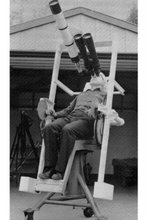
Traditionally, meteorites have been classified by the relative amounts of metal and silicate that they contain. The terms iron, stony-iron, and stone are widely used to categorize meteorites. Irons are composed primarily of metallic nickel-iron, but may contain silicate and other minerals. Stones are made up of mostly silicates, largely iron-magnesium silicates, but may contain more than 24% metallic nickel-iron. The stony-irons are a group of uncommon, ill-defined meteorites that have a large amount of nickel-iron and contain a variety of silicate minerals. The relative abundances of these three groups of meteorites are best represented by the simple statistics of observed falls and finds. Stones account for approximately 63% of meteorites, irons roughly 33%, and stony-irons the remaining 4%.
Of course, there are significant selection factors involved with the recognition of finds by untrained persons, who initially uncover the majority of finds. Irons are relatively easy to distinguish from ordinary terrestrial rocks. They are ferromagnetic, commonly rusty in surface appearance, have a high specific gravity, and have bright white to light gray metallic luster on a freshly filed surface. Another identifying feature of iron meteorites is their ruggedness. They seem to weather less rapidly than many other stones and will persist longer at surface conditions. Stones, on the other hand, require a more careful or trained observer for their recognition. They have many identifiable characteristics (fusion crust, presence of chondrules, minor amounts of metal, etc), but they are not so conspicuous among terrestrial rocks.
There are more than 80 types of minerals that have been found in meteorites, but the t
 otal number of meteorites that have been identified and studied is embarrasingly small. New and unstudied specimens are sorely need by all major universities and science laboratories. If you think you have found a meteorite, please go to this link. Eric Twelker (right) is a very helpful man and will be more than happy to positively identify a meteorite for you. He has helped me with many of my found meteorites (unfortunately, they weren't always meteorites!). Then you can proudly display your sky stones, or sell them to research institutions and universities for some big bucks! The knowledge gained is always priceless!
otal number of meteorites that have been identified and studied is embarrasingly small. New and unstudied specimens are sorely need by all major universities and science laboratories. If you think you have found a meteorite, please go to this link. Eric Twelker (right) is a very helpful man and will be more than happy to positively identify a meteorite for you. He has helped me with many of my found meteorites (unfortunately, they weren't always meteorites!). Then you can proudly display your sky stones, or sell them to research institutions and universities for some big bucks! The knowledge gained is always priceless!

2 comments:
one of my favorite things todo that i do to have fun is to pretend that the coins jingling in my pocket (always fewer than i'd like of course ;-)) are composed of metals that originally fell to earth in a meteoric type of impact crash landing to the earth. and now i use them to buy a candy bar!! maybe even a mars bar or a milky way lol! i'll take anything though - as long as it's chocolate i totally love chocolate!!! :-D
check my web link out!
My Face,
That's a fun thought! And thanks for the internet link! If I ever make it to jolly old England, I'll be sure to donate my pennies!
Post a Comment